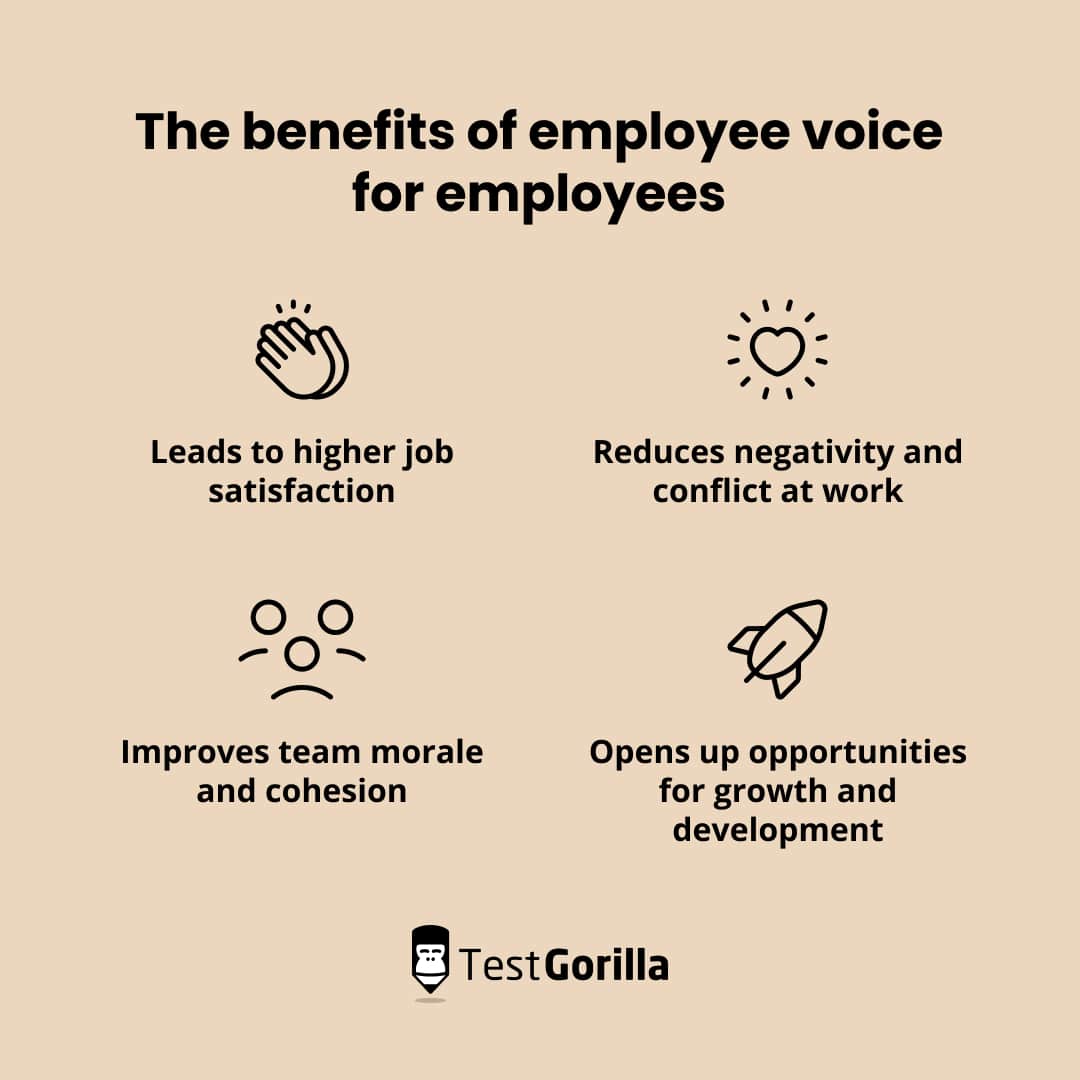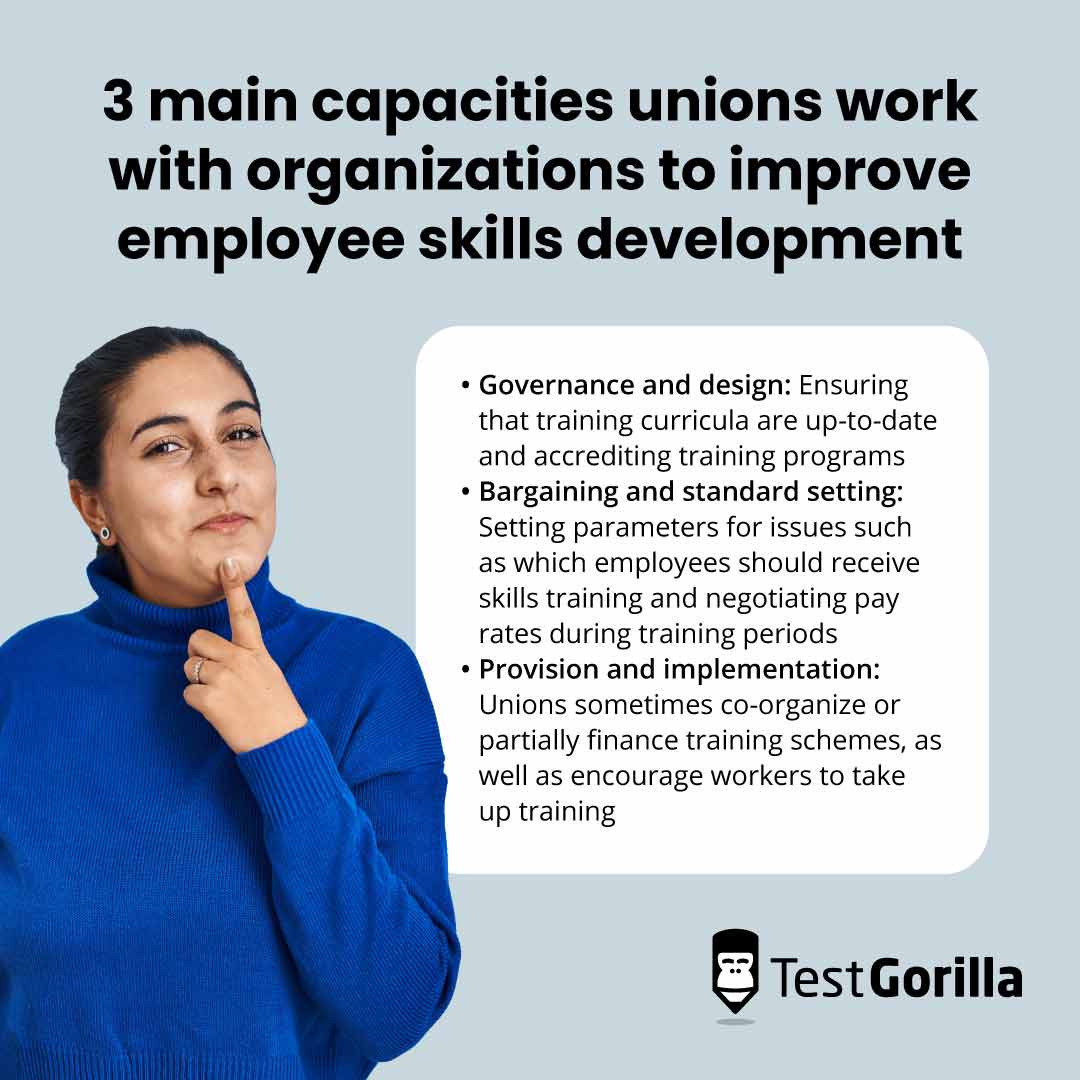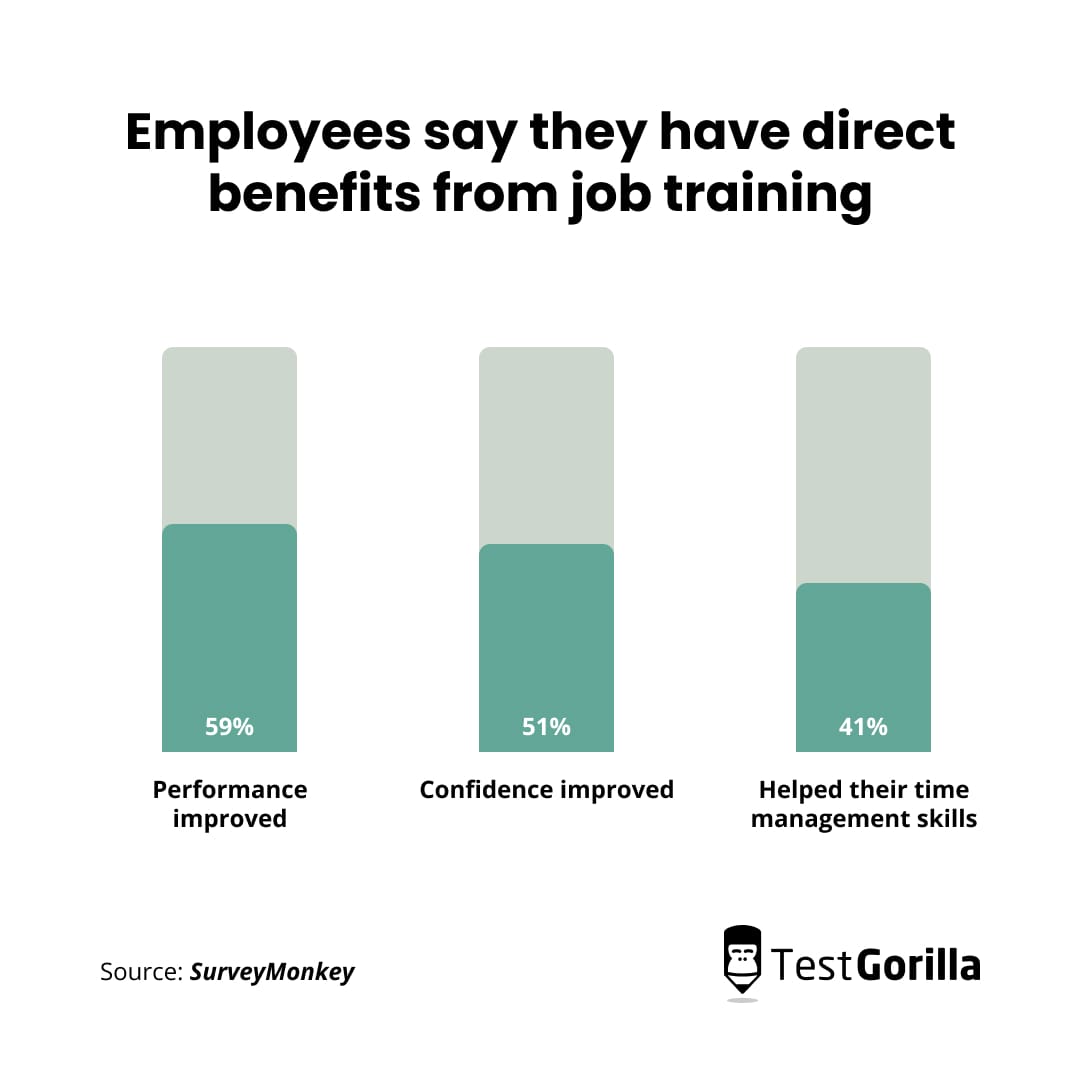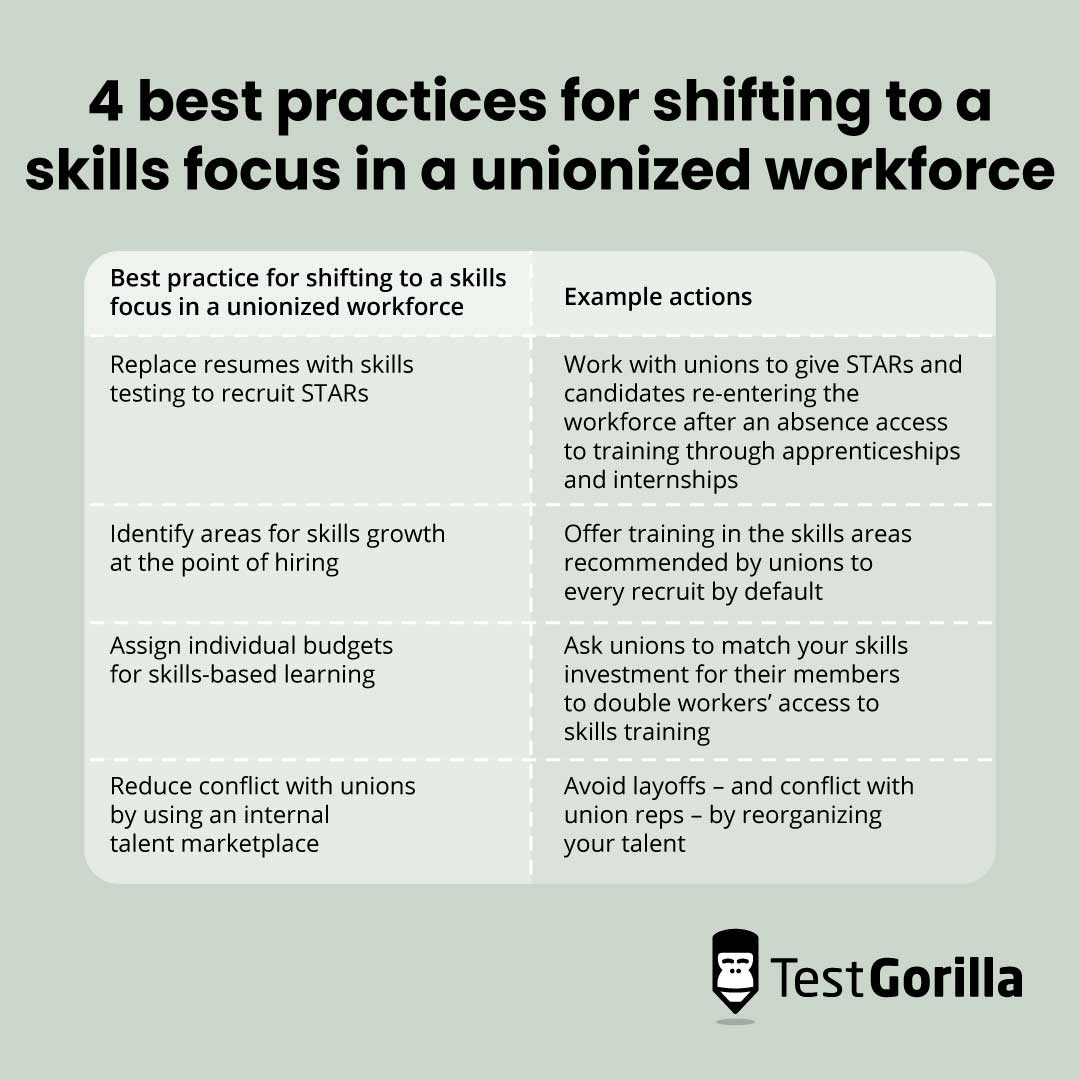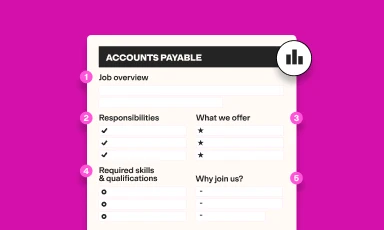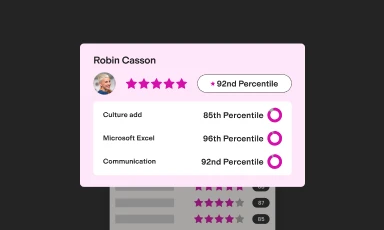Social partnership in the age of skills-based hiring: Could working with trade unions help step up skills?
When you picture working with a trade union as an employer, you probably imagine negotiations fraught with conflict.
Trade unions are often in the news when they sue employers over wrongful termination or poor working conditions.
However, it is possible to strike up mutually beneficial relationships with them for the betterment of your workforce and your bottom line.
Mutual benefits are possible in the era of skills-based hiring when candidates’ skills (rather than experience) are front-of-mind for employers.
Both employers and employees benefit from investing in continual skill development.
This blog discusses how employers can work with unions to step up employee skills development, complete with best practices to follow.
Table of contents
- What is the principle of social partnership?
- Which industries and roles are most commonly unionized?
- How trade unions are involved in skills development
- The benefits of working with trade unions to step up skills
- The risks of working with trade unions to step up skills
- Shifting to a skills focus with a unionized workforce: 4 best practices
- Use skills testing to map the skills in your unionized workforce
- Sources
What is the principle of social partnership?
Social partnership is the term used to refer to the working relationship between employers and trade unions.
These organizations of workers band together to negotiate with employers on matters like compensation and working conditions.
It’s one of the longest-standing ways for employers to listen to “employee voice,” or the employees’ views and suggestions about their work or employer.
Social partnerships aim to combat toxic culture and improve employee experience with minimal damage to business interests.
Social partnerships usually work through union representatives meeting with key leadership figures within organizations to identify common goals and negotiate changes that benefit both parties.
Social partnerships require:
Proactive, open communication about the plans and priorities of organizations and unions
Trust and mutual respect between parties
A constructive approach, with both parties focused on fixes
Which industries and roles are most commonly unionized?
Many of the biggest and most powerful unions worldwide are in the public sector. For instance, in the US, two of the unions with the highest memberships are education unions.
Unions with the highest memberships | Includes | Membership |
National Education Association of the United States | Public school employees, including teachers, cafeteria workers, nurses, etc. | 3,002,516 |
Service Employees International Union | Hotel, restaurant, and hospitality workers, healthcare workers, and public employees | 1,918,192 |
American Federation of Teachers | Public school teachers, registered nurses (RNs), professional, technical, and nonprofessional healthcare workers | 1,677,775 |
This phenomenon is not short-lived: In the UK, for example, union membership in the public sector is consistently higher than in the private sector.[1]
The best insights on HR and recruitment, delivered to your inbox.
Biweekly updates. No spam. Unsubscribe any time.
How trade unions are involved in skills development
Trade unions exist to negotiate better working conditions for their members and boost their satisfaction with their roles. They aim to provide workers with happier, safer, and more secure working lives.
That means working with employers to improve working conditions.
It also requires working with employees to improve their skills to keep up with the demands of the market and advance in their careers.
Securing learning and development opportunities is part of this. These opportunities are often called Vocational Education and Training (VET) and Lifelong Learning (LLL).
Indeed, research conducted by Glassdoor found that three job satisfaction factors consistently rise to the top as predictors of overall employee satisfaction, regardless of location around the world:
Organizational culture and values
The quality of senior leadership
Access to internal career development opportunities[2]
To understand how trade unions are involved in skills training, let’s have a quick look at the history of skills training and unions.
The history of trade unions and Vocational Education and Training (VET)
Trade unions first began in the UK at the end of the 19th century. At this time, union leaders saw more skilled workers as an opportunity to boost collective bargaining power.
They formed learning organizations to provide knowledge and training to their union representatives and members.[3]
However, as the Conservative government of the 1980s fought to deregulate the labor market, it disbanded union-backed industry training boards, and apprenticeships declined.
In the US, similar movements took hold during the early 1900s. However, anti-union sentiments among employers have seen union membership and influence decline since the 1970s, with government support for union-backed skills education waning.
These trends continue today, as many governments have scaled back support for upskilling and reskilling initiatives targeting union workers.
The UK’s government shut down the Union Learning Fund (ULF) in 2021. In the US, the government shuttered a free online community college program for union members for violating financial aid rules.[4][5]
This hostility to unions has created an employer-led model for skills training, with the burden of educating workers falling on employers.
However, despite the obstacles, this mindset is shifting.
Trade unions and skills development now
As the demand for skills-based hiring in the workforce has continued to climb, many countries have shifted back to a more flexible model for skills training.
In this model, there is an opportunity for unions to work with employers to provide skills training that benefits employees’ career outlooks and employers’ business interests.
Unions worldwide have regained some of their power since the pandemic, which boosted union membership, particularly among younger workers.
In 2021, US union membership overall remained flat, but among those aged 25-34, it rose from 8.8% of workers in 2019 to 9.4% in 2021.
This trend was not restricted to the US. In the UK, union membership rose by 118,000, reaching 6.6 million in 2020, the fourth year in a row that the figure had increased.[6]
This jump worldwide is likely because non-union workers were more vulnerable to job losses during the pandemic.
According to the US Department of Labor, non-unionized staff were disproportionately more likely to lose their jobs than unionized employees.
Lockdowns also showed the importance of so-called “low-skill work” to the economy.
They showed the strain such work puts on individuals on the front lines of a global health crisis and the often poor compensation and working conditions they get in return.
Bolstered by this appreciation for low-wage work, new unions also started to form.
A famous example is the Amazon workers’ union, which won the right to form in 2022, though recent efforts to bring cases against the e-commerce giant have stalled.[7]
Particularly younger, less experienced workers feel precarious in their employment after the pandemic and seek out unions to help them gain power in a fluctuating work market.
Meanwhile, employers receive less government support to bring their workforce up to speed with changing skills needs.
In this landscape, the social partnership has emerged as a fix, with unions stepping in to work with organizations to improve employee skills development in three main capacities:
Governance and design: Ensuring that training curricula are up-to-date and accrediting training programs
Bargaining and standard setting: Setting parameters for issues such as which employees should receive skills training and negotiating pay rates during training periods
Provision and implementation: Unions sometimes co-organize or partially finance training schemes, as well as encourage workers to take up training
In Spain, for example, unions are formally consulted on VET implementation.
In Finland, Akava, a major union representing managerial and professional workers, participates in policy-making.
It has also taken over responsibility for services such as career counseling and training in basic professional skills like resume writing and job applications.[8]
An example of employers and unions working together on skills training comes from the Building Trades Union, a North American organization.
It offers earn-as-you-learn apprenticeship opportunities in partnership with employers.[9]
The benefits of working with trade unions to step up skills
In some ways, a workplace with a union presence is an advantage when switching to a skills-based model for hiring and training.
Unionization often creates greater awareness in workers about their careers and position in the labor market.
Skills-based hiring is also fairer than traditional models, shifting focus to each employee’s inherent worker value, a point that many unions would welcome.
Taking this relationship a step further and working directly with unions to step up skills in your workforce has three key benefits.
1. It can help address skills shortages in the sector
There is a global skills shortage, with three-quarters of companies worldwide reporting talent shortages in 2022, the highest figure in 16 years.[10]
Simply put, a skills shortage refers to when a specific skill lacking in an organization (otherwise known as a skills gap) is also hard to find on a broader scale, for instance, regionally or within a specific industry.
Unions, particularly ones that cater to a whole sector, have better oversight than individual employers of what skills are missing among their members.
For example, the Australian Council of Trade Unions (ACTU) has made recommendations to the government regarding the number of workers required to fill roles in industries particularly affected by skills shortages.[11]
Unions also work on the employees’ behalf and, therefore, are looking out for the longer-term view of their careers.
They also look at present skills shortages and how the skills demands are changing.
Looking at longer-term career progression has the potential to be a mutually informative relationship.
Unions and employers can work together to identify the skills needed for the future of work and share responsibility for providing them.
2. Unions may provide funding for training programs
This shared responsibility can take many forms, including union-funded training for workers.
As we’ve mentioned briefly above, many governments have withdrawn support for union-backed skills development owing to the economic downturn.
However, some unions still provide partial funding for training programs.
These training programs especially apply to early-career training, such as apprenticeships and retraining programs.
In these cases, unions take some of the cost burdens off employers to get non-traditional candidates into the workforce – or back into the workforce after updating their skill sets.
One example comes from Belgium, where unions offer career counseling to help workers – especially older ones – manage the digital transition.
Another is the successful initiative Unionlearn in the UK, in which every £1 ($1.27) invested generated an additional £12, either in money or time, with £7 going to employees and £5 to employers.
3. More workers take up training opportunities
As well as unions providing or enabling training opportunities in the first place, there is also evidence that more workers take up training opportunities when they belong to a union.
In the case of Unionlearn, seven out of 10 employees said they would not have accessed skills training without Unionlearn’s help.
Of the participants in the scheme, 90% gained at least one new skill, two-thirds got a qualification, and a quarter gained a promotion or a step up in responsibility.
Other UK research reaches the same conclusion.
A positive correlation exists between the presence of a union learning representative in the workforce and the amount of training that employees access: an 8% bump.[12]
Of course, it’s nice to see that there’s a good use for your money, but more employees accessing training also has wider-reaching benefits.
A survey conducted by SurveyMonkey shows that 86% of employees find job training important, with:
59% of workers reporting improvements in their performance
51% of them reporting improvements in their confidence
41% saying it helps their time management skills[13]
The risks of working with trade unions to step up skills
Although the benefits can be big, working with trade unions can be challenging.
A unionized workforce is likely to be invested in their development. However, unions can create an adversarial relationship between employers and employees.
Each side can present a different view of their responsibilities when seeking and funding skills training.
We found three risks to working with trade unions on skills development.
1. Working with trade unions can affect your growth plans
Many employers are wary of working with unions in any capacity because of their associations with negative business performance.
There is also a common association made between failing businesses and unionization.
However, these projections only pertain to stock value, which is based at least partially on public opinion.
Unionization does not affect profit and return on assets, which means your bottom line is safe, although unionization can affect your growth plans.****[14]
Additionally, unionization is not a random occurrence. It usually occurs for one of two reasons:
The enterprise is highly profitable and, therefore, likely to survive unionization – as in the case of Amazon, described above
As the result of mismanagement or perceived mismanagement, in which businesses are already in trouble[14]
In cases where organizations with unionized workforces do fail, it’s not often as a direct result of union intervention – and working with a union is unlikely to sink a successful organization.
2. It may drive up the cost of training
With unions lobbying for more training, you’re likely to spend more on it than you would otherwise.
In this tumultuous economic climate, this prospect could sound alarm bells. However, investing in training isn’t a bad thing.
More than 90% of chief executive officers who implement upskilling programs see gains in productivity, talent acquisition and retention, and a more resilient workforce.
3. Workers could leave after training
The risk with any development initiative is that a worker uses the training to leverage a better position outside your company.
However, there is evidence that providing skills training makes employees less likely to leave their jobs.
The number one reason people leave their jobs is a lack of learning and development opportunities, so it follows that providing more of these opportunities to more staff can help improve retention.[15]
We would argue that rewarding and retaining talent is often a question of offering development opportunities.
Creating personalized professional development plans is one of our top recommended employee retention strategies for 2023 and beyond.
Unions increase the uptake of skills development training, and this, in turn, can reduce turnover.
Unions boost worker productivity as a result of reduced turnover.
Shifting to a skills focus with a unionized workforce: 4 best practices
We believe it is possible to access the benefits of social partnership regarding skills training and mitigating the risks associated with working with unions.
Here are four best practices to ensure you get it right.
4 best practices for shifting to a skills focus in a unionized workforce: Summary table
Already working with a unionized workforce and need to get started, well, yesterday?
No problem – here’s the short version:
1. Replace resumes with skills testing to recruit STARs
First, throw out the resumes you’ve been using to screen candidates.
Besides opening the door for unconscious bias, they also unfairly discriminate against candidates based on arbitrary details like:
Educational history
Whether they have gaps in their resume
The presence of highly-specific keywords
Resumes leave STARs, or employees skilled through alternative routes, out of your hiring process although they have all the skills necessary to complete the role.
STAR candidates often hit the “paper ceiling” when their lack of a degree shuts them out of promotion opportunities or even getting a foot in the door at great companies.
When accessing this untapped workforce, you can work with unions to train STAR employees who have previously only experienced low-skill roles either in your organization or outside of it.
Capture these STARS through union-assisted apprenticeships or internships.
This strategy anticipates unions’ goals to distribute skills training more evenly throughout the workforce, since low-skilled workers receive less investment in skills than those in middle- and high-skill roles.
Besides doing social good, it also benefits your business because, despite their popularity, resumes are not useful hiring tools.
Prehire work experience – the key information in a resume – is a poor indicator of candidates’ future job performance and retention.[16]
2. Identify areas for skills growth at the point of hiring
Using employees’ initial skills test results, proactively identify areas where they could use extra development.
For example, if a candidate scores lower (yet not low enough to cause concern) on one key skill area, you can offer additional training as part of their onboarding process.
You should also look at additional skills that could become necessary, starting with the areas identified by unions as key to the future of work.
If a union has training programs to address this skill, you can work side-by-side with the union to improve their skill level.
If the union has recommended skill areas where all workers need to grow to meet demand, you can offer this training by default.
Besides looking at your business needs and the recommendation of unions, you should work with the employee to understand where they want their career to take them and manage it alongside them.
Working with employees promotes internal mobility, which is better for engagement and retention.
Did you know that employees who move jobs internally are three times as likely to be engaged as employees who stay in their current roles?[17]
For the best results, use this strategy alongside talent mapping to anticipate how an employee’s career trajectory aligns with your business goals and growth plans.
They could need these skills to access internal promotion into the roles directly above them.
For instance, to move a worker from a social media manager role into a head of social media or a social media strategist role, you can train them in social media strategy.
You can also use their early skills tests to identify the skills they have that are adjacent to other potential skill sets.
Transferable skills are particularly important in rapidly changing roles, for instance, administrative positions that are vulnerable to automation.
Finally, you can routinely test your whole workforce to identify those with promising skills who can advance as leaders.
These goals crucially intersect with unions’ overall goal of more secure and long-lasting employment for their members, which reduces friction with representatives.
3. Assign individual budgets for skills-based learning
One of the most effective ways to implement upskilling initiatives is to give each employee a budget for training.
This policy is in place for our employees at TestGorilla.
We offer every employee a personal development budget equal to 3.5% of their annual salary. All they need to do is submit their choice of program to their line manager for approval.
If needed, they can even take time off to pursue specific L&D objectives.
We believe this approach is a powerful part of any talent strategy because it is easy to budget and gives employees autonomy over their training.
It’s also useful because it shows clear investment in your workers, an advantage in any union discussion.
You could even have access to greater funding in a unionized workforce than in a non-unionized one.
For example, you could ask unions to match your skills investment for their members to double workers’ access to skills training, either by providing their training or by funding an outside program.
Alternatively, you could access discounted or union-subsidized training for key skills the union has identified, leaving more in the budget for other training.
4. Reduce conflict with unions by using an internal talent marketplace
Finally, one of the key sites for conflict between organizations and unions is when you are considering laying off employees.
Layoffs are a vulnerable time for any employer, potentially opening you up to unfair dismissal lawsuits and unions contesting your layoff decisions.
Limit the impact of layoffs by using an internal talent marketplace.
This software or spreadsheet stores the skill information you receive during hiring to help you make strategic internal hiring decisions.
When times are bad, it can help you identify opportunities for redeployment to conserve your talent and reduce the impact of mass layoffs.
When times are good, it helps you identify opportunities for internal mobility to reduce the need for external hiring, saving on costs.
For instance, you notice that an overstaffed team contains an employee with adjacent skills to an understaffed one, so you approach this employee about switching over.
Reducing the impact of layoffs on your organization is one of the most effective ways to reduce opportunities for arguments with representatives.
It’s also essential in the current climate of economic uncertainty because layoffs can tank productivity.
More than 70% of employees say their productivity declines after layoffs and 69% say the quality of the company’s product or service declines too.[18]
Use skills testing to map the skills in your unionized workforce
Employers often view unions as mortal enemies, but that’s not how it should be.
With the right management, social partnerships can bring about benefits for workers and agility to your workforce and your all-important bottom line.
To get started with the best practices laid out above, read our blog about assessing your employees’ skills.
If you want to know how to anticipate your unionized workforce’s skills needs, read our guide to talent planning.
Finally, use our Leadership and People Management test to identify future leaders and track their progress through training programs.
Sources
“Trade Unions: an introduction”. (July 12, 2022). CIPD. Retrieved June 20, 2023. https://www.cipd.org/uk/knowledge/factsheets/trade-unions-factsheet/
Stansell, Amanda. (July 11, 2019). “Which Workplace Factors Drive Employee Satisfaction Around the World?”. Glassdoor. Retrieved June 20, 2023. https://www.glassdoor.com/research/employee-satisfaction-drivers/
Clough, Bert. (April 2016). “The role and impact of unions on learning and skills policy and practice: a review of the research”. Unionlearn. Retrieved June 20, 2023. https://www.unionlearn.org.uk/sites/default/files/publication/Research%20Paper%2016.pdf
Benn, Melissa. (February 6, 2021). “UK ministers accused of ‘settling scores’ by axing union adult learning fund”. The Guardian. Retrieved June 20, 2023. https://www.theguardian.com/education/2021/feb/06/uk-ministers-accused-of-settling-scores-by-axing-union-adult-learning-fund
D’Agostino, Susan. (July 20, 2022). “Education Department Shuts a ‘Free’ Program for Union Members”. Inside Higher Ed. Retrieved June 20, 2023. https://www.insidehighered.com/news/2022/07/21/us-shuts-community-colleges-free-program-union-members
Elliott, Larry. (May 27, 2021). “Membership of UK trade unions rises for fourth year in a row”. The Guardian. Retrieved June 20, 2023. https://www.theguardian.com/politics/2021/may/27/membership-of-uk-trade-unions-rises-for-fourth-year-in-a-row
Sainato, Michael. (April 8, 2023). “‘War of attrition’: why union victories for US workers at Amazon have stalled”. The Guardian. Retrieved June 20, 2023. https://www.theguardian.com/technology/2023/apr/08/long-fight-organize-us-workers-amazon
“Unions and Skills TUAC discussion paper on OECD strategies for skills, Jobs and the Digital Economy”. (July 22, 2016). TUAC. Retrieved June 20, 2023. https://tuac.org/wp-content/uploads/2018/06/1607t_unions-skills.pdf
“North America’s Building Trades Unions’ CONSTRUCTION REGISTERED APPRENTICESHIP”. NABTU. Retrieved June 20, 2023. https://nabtu.org/apprenticeship-and-training/
“The Talent Shortage”. (2022). ManPowerGroup. Retrieved June 20, 2023. https://go.manpowergroup.com/talent-shortage
Karp, Paul. (August 16, 2022). “Unions and employers agree 40,000 more migrants a year needed to fill Australia’s skills shortage”. The Guardian. Retrieved June 20, 2023. https://www.theguardian.com/australia-news/2022/aug/17/unions-and-employers-agree-40000-more-migrants-a-year-needed-to-fill-australias-skills-shortage
Bridgford, Jeff. (2017). “Trade union involvement in skills development: an international review”. International Labour Organization. Retrieved June 20, 2023. https://www.ilo.org/wcmsp5/groups/public/—ed_emp/—ifp_skills/documents/publication/wcms_585697.pdf
Gitlin, John. “Why employees crave more training and how employers aren’t delivering it”. SurveyMonkey. Retrieved June 20, 2023. https://www.surveymonkey.com/curiosity/why-employees-crave-more-training-and-how-employers-arent-delivering-it/
Bruner, Raisa. (April 21, 2022). “American Companies Have Always Been More Anti-Union Than International Ones. Here’s Why”. Time. Retrieved June 20, 2023. https://time.com/6168898/why-companies-fight-unions/
“2019 Retention Report”. (2019). Work Institute. Retrieved June 20, 2023. https://info.workinstitute.com/hubfs/2019%20Retention%20Report/Work%20Institute%202019%20Retention%20Report%20final-1.pdf
Van Iddekinge, Chad, et al. (June 21st, 2019). “Previous work experience is not a good predictor of how people will perform in a new job”. London School of Economics. Retrieved June 20, 2023. https://blogs.lse.ac.uk/politicsandpolicy/previous-work-experience-is-not-a-good-predictor-of-how-people-will-perform-in-a-new-job/
“Workplace Learning Report”. (2021). LinkedIn Learning. Retrieved June 20, 2023. https://learning.linkedin.com/content/dam/me/business/en-us/amp/learning-solutions/images/wlr21/pdf/LinkedIn-Learning_Workplace-Learning-Report-2021-EN-1.pdf
Murphy, Mark. (November 26, 2020). “Don’t Expect Layoff Survivors To Be Grateful (Survivor’s Guilt After A Downsizing)”. Leadership IQ. Retrieved June 20, 2023. https://www.leadershipiq.com/blogs/leadershipiq/29062401-dont-expect-layoff-survivors-to-be-grateful
You've scrolled this far
Why not try TestGorilla for free, and see what happens when you put skills first.


